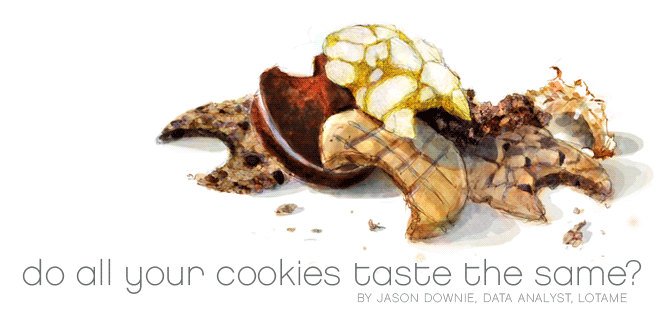
When considering which data to buy and layer onto campaigns, marketers are becoming lost in a sea of segments. Several data buyers have told me they have access to 50,000 segments. That’s 50 with 3 zeroes. Which cookies should you buy? How can you differentiate one company’s 500 segments from the thousands of others available out there? “Automotive Data from Company 1” is indistinguishable from “Automotive Data from Company 2” in a buyer UI.
(Story image by Robert Roxby.)
One useful distinction to note when deciding on purchases is whether the data is sourced offline or online. For the last two years, the old and new worlds of data collection have been colliding, and they are very, very different.
The offline data industry is well-established. Companies have been collecting data on consumers, and marketing to them based on that data, for well over 100 years. They can count every piece of mail sent, every record sold, every green lead card (think Glengarry Glen Ross) generated. Profit margins are known.
And most important, data collection practices are well-established. Every single offline data giant knows where to get demo data (Census, birth records, other government sources), HHI and car type (modeled off of Zip+4), purchase data (credit card companies), level of credit (credit bureaus) and home type and value (state and county records).
These companies have jostled for market position for decades, and have differentiated on scale, quality of modeling algorithms, efficiency of data warehousing and delivery, marketing, sales and customer service. But they are all using the same basic data sources to generate very similar data. Fifty different websites boast a “database with 5,000 fields covering 220 million households.” All are racing to get the same data sets online.
The scale of the cookie pools of offline data companies has become their biggest differentiator. The strategy is “Find a match partner, and scale it up!” Because their data all comes from the same offline sources, the only question online marketers have to ask is: “How big are ya?” Whether you are buying from Companies A, B, C, or D, you are buying the same cookies.
Conversely, companies that source their data online are often very different. “Data networks” can collect proprietary data in a privacy-safe manner that tends to be both granular and unique. The Internet is alive with emotion, social activity and a vast array of entertainment, news, information and education. There is no way to fake collection of this data. Nor is there a way to model it with complete accuracy. There is no way to refer to census data, model on ZIP+4, or check with the credit bureau.
Instead, the data comes from the observation, collection and organization of the activity of anonymous users. A good online data provider will augment its data set with an offline cookie base, but that’s the easy part. The secret sauce is collecting data that can’t be obtained anywhere else. Each online data network will have access to its own special blend of sports, news, fashion, comedy, television, online dating and social media sites. Each data set is unattainable anywhere else. Period.
For example, at Lotame we have compiled a deep and broad set of data from a hugely diverse set of sources: more than 100 major online publishers and several innovative offline providers. We’ve built a data network of almost 300 million unique users, who exhibit behaviors in more than 3,500 categories that our technology enables us to comprehend, sort and deliver to marketers.
Given these capabilities, a sample “value chain” of collecting data on online users might look like this: one of several offline companies tells the online data provider that a particular group of users is female, between 25-35, with household incomes of $50,000 to $75,000.
The online provider then adds to the profiles what they (and only they) have found out: some of these middle-class young-adult women visited sports sites recently. A small fraction read articles about the Dallas Cowboys. Some visited fashion forums, and answered posts about where to go for the best discounts on new shoes. A few others uploaded vacation photos, visited news sites and read articles about politics. Some took quizzes on dieting do’s and don’ts, and a few of them published those quiz results, and shared them with friends on Facebook.
The online provider can build audiences of millions of people like this for marketers to target. That’s why brands find this data so valuable.
Some cookies taste store-bought. Others taste homemade. Which ones would you rather have?